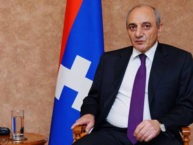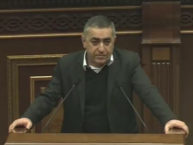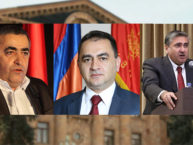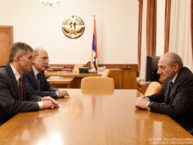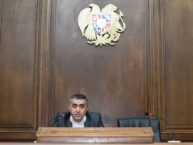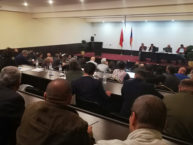By Dikran Kaligian
The Armenian Weekly
April 2009 Magazine
The Armenian Revolutionary Federation-Dashnaktsutyun (ARFD) and the Hnchak Party entered into a dialogue with Turkish opposition groups in Paris in 1900 and took part in the First Congress of Ottoman Opposition Forces in 1902. At the end of 1907, the Second Congress of Ottoman Opposition Forces resolved to overthrow the Sultan and to restore the Ottoman constitution using much more radical means, including refusal to pay taxes, propaganda, and armed resistance, if necessary.
Thus, the successful Constitutional Revolution of 1908, initiated by a rebellion of the Turkish army in Macedonia, was greeted with jubilation by all opposition parties and much of the population of the empire.
The ARF published and distributed a proclamation that celebrated the success of the revolution and looked forward to freedom, equality, and justice under the constitutional regime. Accordingly, the party published a program that recognized the territorial integrity of the Ottoman Empire. The program called for a federal form of government with a decentralized administration that would provide the widest degree of local autonomy.
The CUP (Committee of Union and Progress or Ittihad) and the ARF became key players in Ottoman constitutional politics.
For the ARF to influence government policies to improve conditions for the Armenians, it would have to work closely with the CUP. Communication between the parties was immediately hampered, however, by the fact that neither was headquartered in the imperial capital, Constantinople.
At the end of 1908, elections were held throughout the empire and a multi-ethnic parliament was seated. Of the 11 Armenians elected, 4 were ARF members representing the eastern provinces. The restoration of the constitution allowed the Armenian parties to openly campaign in the elections and start publishing newspapers within the empire.
In this atmosphere of increasing liberties, an armed insurrection broke out on April 12, 1909 in Constantinople and succeeded in driving the CUP out of the city. Liberal opponents of the CUP as well as reactionaries and supporters of Sultan Abdul Hamid supported the coup. However, within two weeks, troops under Mahmut Sevket Pasha had suppressed the revolt. Taking advantage of the political unrest, anti-Armenian massacres broke out in the city of Adana and the towns and villages of Adana province. In all, some 25,000 Armenians perished in the two rounds of massacres.
The Adana massacres created the first major test for ARF-CUP relations. The ARF had to decide, in the face of Armenian public opinion, whether to continue its cooperation with the CUP. This was dependent, on the one hand, on an evaluation of the degree of culpability of the CUP. On the other hand, the ARF had to weigh the substantial potential benefits to the Armenian community and all Ottoman citizens if the CUP instituted a true constitutional regime.
Weighing the Options
The ARF found itself in a serious dilemma. The party was torn between its solidarity with the progressive elements of the CUP and its revulsion at the murderous acts of its chauvinist elements.
The Western Bureau desired to help the progressive elements consolidate power within the party and the empire. Yet should the progressives lose the upper hand, the consequences for the Armenians would be deadly. The ARF self-defense units had been disbanded, which would leave the population in the eastern provinces and Cilicia at the mercy of Kurdish tribes or Turkish mobs.
After weighing all these considerations, the Western Bureau decided to make a final attempt at continued cooperation with the CUP. The attempt would be conditional on the government taking action on a number of critical items arising from the massacres.
The CUP took great pains to reassure the ARF of their sincerity and support of reforms. They met in Salonika to draw up an accord that committed the two parties to preserve the empire, provide an increased devolution of power to the provinces, and to defend the constitution against reactionary movements.
The agreement to continue cooperation was a serious political gamble by the ARF. The credibility that the ARF had gained through years of self-defense actions and political education and organizing activities would be lost if the CUP did not deliver on its promises. But such was the belief of the ARF leadership in the benefits of constitutionalism that they were willing to give it one more try.
There would no longer be an endless supply of patience or goodwill, however. There was a heightened level of distrust by the party ranks, and power struggles within the CUP would have to be monitored closely to determine which group held the upper hand. The CUP’s room to maneuver was thus seriously circumscribed. If the CUP were unable to deliver promptly on its promises, due to the serious institutional and political obstacles, the ARF would be unable to give much slack before breaking off relations.
ARF-CUP Relations
For the first 18 months after the Constitutional Revolution, the Western Bureau’s relations with the CUP were irregular due to internal problems within the CUP. The relationship and communications started to become more regular at the beginning of 1910 when a “Joint Body” was formed. It was composed of three ARF members and three CUP members.
A critical component of the relations between the parties was correcting the many false reports and rumors that were circulating. In order to foster support of the constitution and constitutional regime, it was also important to send fieldworkers into the provinces to extol the virtues of a constitutional regime and to counsel patience for improvements. From the beginning, the ARF stressed the need for joint ARF-CUP delegations, as they would demonstrate to Turks and Armenians that the constitution would not benefit any one ethnic group to the exclusion of others.
The Western Bureau felt obliged to take action as for more than a year their numerous protests and demands had remained unanswered and the condition of the provinces had gradually worsened. On March 20, 1910, they sent Harutiun Shahrigian and Arshag Vramian to Salonika with official documents to meet with the CUP Central Committee members. The most important subjects were the lands issue, the security of the Armenians, and the educational issue. Their reception was very cordial. The Central Committee tried in every way to convince the Bureau representatives that the CUP’s policy had not changed toward the ARF. They emphasized that they knew that the Armenians had stood by the constitution and loyally supported it. The Bureau deemed the results of the Salonika meeting to have been satisfactory.
In July, the Western Bureau reported that their relationship with the CUP had become closer and friendlier. The unrest in the interior had brought home to the CUP the need to have the backing of a trustworthy organization like the ARF.Also, the appointment of
Talaat and Cavid Beys to the cabinet created a steadier channel for communication and improved relations between the parties.
Yet, in reporting on two years of relations with the CUP, the Western Bureau stated that despite its best efforts, the Joint Body meetings did not convene regularly; sometimes months would pass without a meeting. From its formation until mid-1911, only 16 meetings were held. Among the reasons cited were the frequent crises within the CUP or in their ministries, their inexperience and inefficiency, and their discomfort at having to admit their inability to accomplish the objectives agreed upon with the ARF. Outside of the formal meetings, however, there were a number of encounters with individual ministers or CUP leaders that were productive.
The Deterioration of Relations with the CUP
The ARF-CUP joint body met in February 1911. They had a heated discussion regarding events and conditions in the provinces. The CUP representatives had to admit that their party was not a strong presence in the interior.
The Western Bureau later had a joint meeting with the Armenian parliamentary deputies. They concluded that: the government had not shown good will towards the Armenians, protests had been growing stronger in the provinces, local government employees were still biased against Armenians, and the government had not made any strong and serious effort to change these conditions. On this basis, the meeting decided to again send
Vramian and Shahrigian to Salonika to present the lands, security, and educational problems faced by the Armenians to the CUP and to demand satisfaction. The Bureau stated that they would determine their position towards the CUP based on its response to the ARF demands. Vramian and Shahrigian met with the CUP Central Committee and reported that they had received satisfactory responses to their demands. The lands issue was the top ARF priority and the CUP agreed that it would be resolved administratively and not sent to parliament. On security issues, they agreed to try to send trouble-making beys out of the country to prevent the nomads from doing further damage.
The joint body met in Constantinople in April. The Bureau decided to postpone other issues and concentrate only on the lands and security issues at the meeting. At the meeting, the CUP agreed to take steps to control persecution, although it would have to be done over time. To do this, it was agreed to have the government arm all villages, Armenian and Kurdish. This would allow the villagers to defend themselves against nomadic Kurds.
On April 24, the Western Bureau met with Talaat, Haji Adil, and Midhat Beys. They discussed the promises made at the Salonika meeting. The CUP representatives explained that they were in a weak position and would be unable to push for any reforms for the present. They proposed to have their deputies introduce the issues in parliament and they had already passed on copies of the accord articles to the deputies.
In June, it was noted that the Armenian deputies would soon be presenting a written application detailing their specific demands to the Interior Ministry and that the Western Bureau would present the same to the CUP. The response to these demands would help determine the position of the Bureau towards the government until the ARF World Congress.
These were the circumstances when the ARF Sixth World Congress convened in Constantinople in the summer of 1911. The main agenda item was the question of cooperation with the CUP. Despite ratifying the past actions concerning cooperation, the meeting was extremely critical of the CUP’s duplicity and failure to live up to its promises. After evaluating the prospects and dangers of continued cooperation, the World
Congress passed a resolution that stated: “. . . in the three years of constitutional rule the government’s policies not only haven’t created an improved life. . . but they have generally given way to creating distrust between peoples and the denial of national rights. The CUP, rather than progressively eliminating the land privileges of the feudal classes left over from the Middle Ages, has encouraged those elements. . . The CUP has gradually withdrawn from constitutional and democratic principles. The CUP has failed to take steps to combat and cleanse itself of right-wing elements. . .” The resolution directed the Western Bureau to send the CUP a description of the anarchy in the Armenian provinces and an ultimatum that if action wasn’t taken by a set deadline, they would end cooperation between the parties.
The 1912 Elections and the End of Cooperation with the CUP
The lack of progress in land reform and improved conditions for Armenians, and the ascendancy of reactionary elements within and without the CUP, had brought ARF-CUP cooperation almost to the breaking point. Early 1912 would bring an immediate test of this cooperation in the form of parliamentary elections. In the run up to the elections, the CUP leadership felt it had to strengthen the cabinet, and its own position in it. Therefore three CUP members were added to the cabinet: Haji Adil as Interior Minister, Talaat as Minister of Posts and Telegraphs, and Cavid as Minister of Public Works.
The agreement between the CUP and Western Bureau was that Armenian candidates would be put forward in all locations where the Armenian population comprised a significant percentage. In planning for an Armenian bloc in parliament, the Eastern Bureau was counting not only those seats conceded to them by the CUP, but also those Armenians who had joined the CUP.
Negotiations continued with the CUP agreeing upon 13 Armenian deputies, to that point, and which districts they would be elected from. Negotiations continued regarding the other 10 seats. However, they found that the local CUP was trying to renege on its promises of Armenian representation for a number of locations including Erzingan,
Diyarbekir, Kharpert, and Marash. The Western Bureau’s relations with the CUP deteriorated greatly as the electoral machinations continued. The Bureau had concentrated on reaching an agreement on improvements in conditions for Armenians before they began negotiations specifically on parliamentary representation, as the former was such an urgent issue. The CUP did not deal honestly with the ARF, particularly when they improperly decreased the number of Armenian deputies to be elected. Even more important to the ARF, they complied with almost none of the demands contained in the accord they had signed with the ARF two and a half months before the elections.
As a result, the Bureau presented an ultimatum to the CUP that provided a final chance to implement the accord conditions including: forming a committee to oversee accord implementation, creating Armenian and Kurdish village guards in Van and Bitlis provinces, ensuring the right of return with a government subsidy for Armenian refugees, recruiting 200 Armenian soldiers for each Armenian province to serve as gendarmes, and appropriating promised government funds for Armenian schools.
If the CUP failed to order these administrative changes within 15 days, the ARF would end cooperation, consistent with the decision of the Sixth World Congress. The Eastern Bureau disagreed with the Western Bureau’s condemnations of the CUP. They called for the Bureau to keep perspective on the fact that the CUP signing of the preliminary agreement before the election did not mean that all its points would be immediately executed.
The Eastern Bureau argued that even though the World Congress had authorized the Western Bureau to break relations, it was premature to do so. There had been changes in conditions and the elections and other political complexities had not been anticipated by the congress. They felt that the ARF should wait a little longer for the CUP to regroup its strength and thus have a chance to execute the ARF demands.
On July 15, 1912, Said Pasha’s cabinet won a vote of confidence; yet two days later, it fell. The Western Bureau saw that they were in a no-win situation. In spite of the CUP’s deceptions, manipulations, false promises, and delays in reforms, they were still the only party that the ARF could negotiate with. The Bureau saw the CUP as a lesser evil when compared to their opponents, and for that reason ended its press criticism of them. It was important to jolt them into awareness but a complete disintegration of interrelations would be bad for the Armenians.
During the second week of August, the bureaus announced in “Azadamard” in Constantinople and in “Haratch” in Erzerum that they had broken off relations with the CUP. Further they stated that they would maintain a position of neutrality during the conflict between the Turkish parties in the parliament.
The outbreak of the First Balkan War and the party’s break with the CUP increased the danger to the Armenian population. Thus, Rosdom and Mourad [of Sepastia] went to Constantinople to meet with Simon Zavarian, the only agenda item of their meeting being how to arm themselves and protect the people. In the course of the meeting, they determined that to reestablish the self defense structure was going to require years, money, resources, and leadership, none of which was currently available.
During 1913, the ARF and the Patriarchate worked together to gain the support of the European powers for an effective reform plan for the Armenian provinces. With German support, the Ottomans succeeded in delaying the appointment of two European inspectorsgeneral until the eve of World War I.
The ARF Eighth World Congress and the Approach of War
The ARF World Congress was held in Erzerum in August 1914. A committee of nine was formed to stay and while they were meeting, Dr. Behaeddin Shakir and Naji Bey arrived as representatives of the CUP and the government. They met for three days and asked what the ARF stance would be if Russia invaded the Ottoman Empire. The ARF representatives responded that the party would obviously defend the sovereignty of the Ottoman Empire.
After lengthy discussions, the CUP representatives disclosed that the government had decided to take advantage of what they hoped would be the German defeat of France and Russia to take care of their own unfinished business to recover lost lands. Further, should the Russians be completely defeated, they would advance to the Caucasus to either conquer or incite a revolution. The Armenians were a key to success, because they believed that the ARF had the power and ability to persuade the Russian Armenians to remain loyal to the Russian government until a critical juncture at which time they would shift their allegiance to the Turks. The government had no interest in occupying the Caucasus, but merely wanted to pull it out of Russia’s orbit and then give it autonomy.
The ARF representatives responded that Russian Armenians no longer had the enthusiasm for Ottoman constitutional rule they had had from 1908–10. The errors made by the government and CUP in regards to Ottoman Armenians would give Russian Armenians no confidence that support for the Ottoman government would improve conditions for their compatriots across the border.
In Constantinople, Talaat expressed his disappointment in the party’s stance to ARF parliamentarian Armen Garo. The Bureau called a consultative meeting with its key members as well as Krikor Zohrab. The meeting was divided between those who expected a speedy Russian victory over the Ottoman armies and those who feared a lengthy campaign fought largely in Armenian- populated lands. In either case, volunteer units had to be ready to defend the Armenian population if massacres began, while somehow not appearing to be a fifth column and thus providing a pretext for such massacres. This was the tightrope the ARF had to walk as the guns of war approached.
Dikran M. Kaligian has been Visiting Professor of Armenian Genocide Studies at Clark University and has also taught at Westfield State and Wheaton Colleges. He currently teaches at Regis College and is Managing Editor of the Armenian Review. He received his doctorate in history from Boston College. He is the author of Armenian Organization and Ideology under Ottoman Rule: 1908-1914, published by Transaction Publishers in February of 2009.


